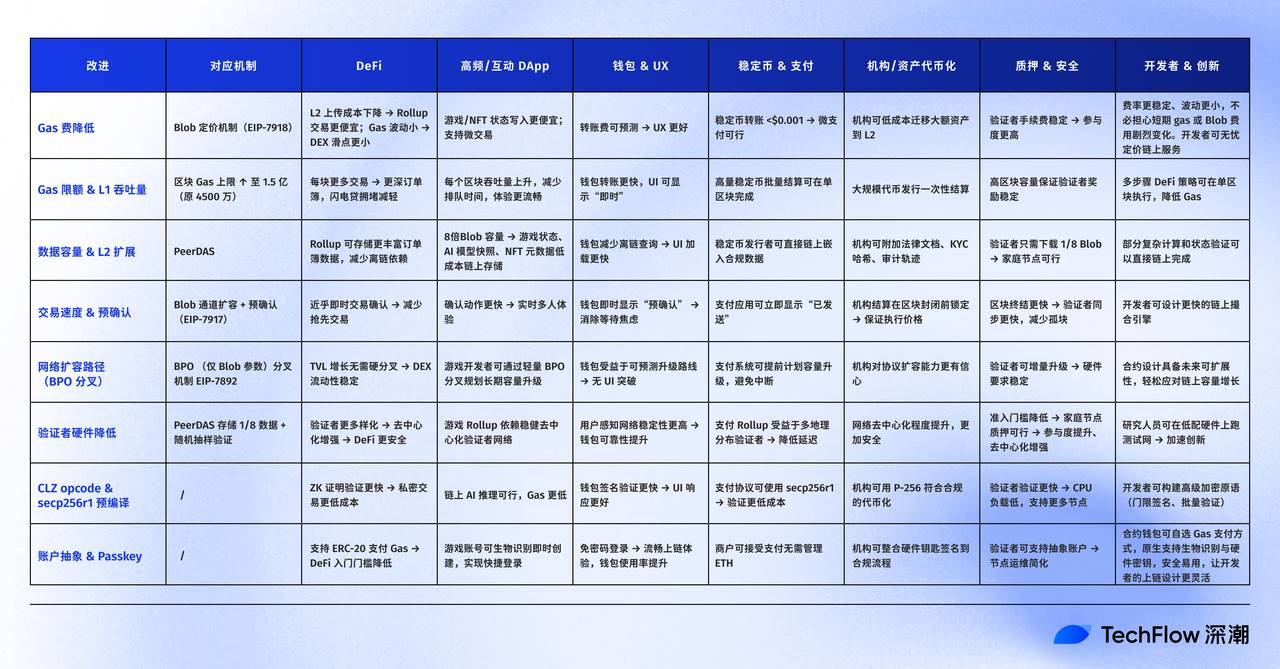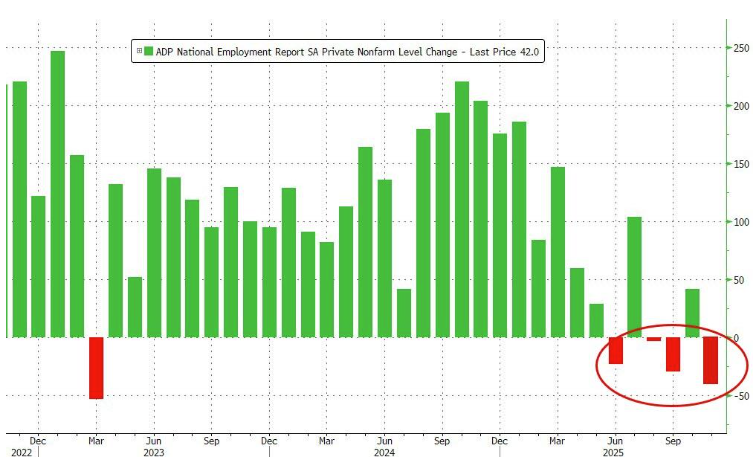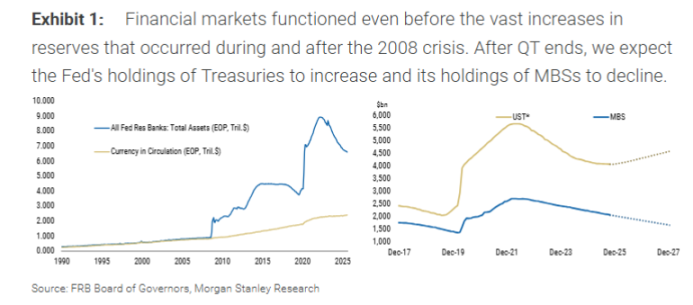After a weak performance last week, the Ethereum spot ETF has once again recorded net inflows, and market sentiment is gradually warming up. Ethereum’s next upgrade is already on the way.
Looking back at history, almost every technical upgrade has become a catalyst for price, with the improved on-chain performance after upgrades directly reflected in ETH’s valuation expectations.
This time, the Fusaka upgrade coming on December 3 will be broader in scope and deeper in impact.

It’s not just an efficiency optimization, but a major upgrade to the entire Ethereum mainnet: Gas costs, L1 throughput, L2 capacity, node thresholds... almost every core metric that determines the network’s vitality is taking a big step forward.
If previous upgrades made Ethereum “cheaper” or “faster,” then the significance of Fusaka lies in making Ethereum more scalable and sustainable.
As protocol functions become increasingly complex and the requirements for the underlying chain’s capacity rise, with the rise of AI Agents and high-frequency interactive DApps, this upgrade will directly impact Ethereum’s position in the next wave of Web3 applications.
So, what exactly is changing? If you want a quick overview, here’s a one-picture summary of all the core changes in the Fusaka upgrade:
| Improvement | Corresponding Mechanism | DeFi | High-frequency/Interactive DApp | Wallet & UX | Stablecoins & Payments | Institutions/Asset Tokenization | Staking & Security | Developers & Innovation |
| Lower Gas Fees | Blob Pricing Mechanism (EIP-7918) | L2 upload costs decrease → Rollup transactions become cheaper; less Gas volatility → smaller DEX slippage | Cheaper game/NFT state writes; supports microtransactions | Transfer fees become predictable → better UX | Stablecoin transfers at $0.001 → micro-payments become feasible | Institutions can migrate large assets to L2 at low cost | Validator fees become stable → higher participation | More stable and less volatile rates, no need to worry about short-term gas or blob fee spikes. Developers can confidently price on-chain services |
| Gas Limit & L1 Throughput | Block Gas Limit ↑ to 150 millions (from 45 millions) | More transactions per block → deeper order books, reduced flash loan congestion | Increased throughput per block, reduced queue times, smoother experience | Faster wallet transfers, UI can display “instant” | High-volume stablecoin batch settlements can be completed in a single block | Large-scale token issuance can be settled at once | High block capacity ensures stable validator rewards | Multi-step DeFi strategies can be executed in a single block, reducing Gas |
| Data Capacity & L2 Scaling | PeerDAS | Rollups can store richer order book data, reducing off-chain reliance | 8x Blob capacity → low-cost on-chain storage for game states, AI model snapshots, NFT metadata | Wallets reduce off-chain queries → faster UI loading | Stablecoin issuers can embed compliance data directly on-chain | Institutions can attach legal documents, KYC hashes, audit trails | Validators only need to download 1/8 of a blob → home nodes become feasible | Some complex computations and state verifications can be completed directly on-chain |
| Transaction Speed & Pre-confirmation | Blob channel expansion + pre-confirmation (EIP-7917) | Near-instant transaction confirmation → reduces front-running | Faster confirmation actions → real-time multiplayer experience | Wallets instantly display “pre-confirmation” → eliminates waiting anxiety | Payment apps can immediately display “sent” | Institutional settlements are locked in before block closure → ensures execution price | Faster block finality → faster validator sync, fewer orphan blocks | Developers can design faster on-chain matching engines |
| Network Scaling Path (BPO Fork) | BPO (Blob-only parameter) fork mechanism EIP-7892 | TVL growth without hard fork → stable DEX liquidity | Game developers can plan long-term capacity upgrades via lightweight BPO forks | Wallets benefit from predictable upgrade paths → no UI disruptions | Payment systems can plan capacity upgrades in advance, avoiding interruptions | Institutions have more confidence in protocol scalability | Validators can upgrade incrementally → stable hardware requirements | Contract design is future-proof, easily handling on-chain capacity growth |
| Lower Validator Hardware Requirements | PeerDAS stores 1/8 data + random sampling verification | More diverse validators → enhanced decentralization → safer DeFi | Game rollups rely on robust decentralized validator networks | Users perceive higher network stability → improved wallet reliability | Payment rollups benefit from geographically distributed validators → reduced latency | Increased network decentralization, greater security | Lower entry barriers → home node staking becomes feasible → increased participation, enhanced decentralization | Researchers can run testnets on low-spec hardware → accelerated innovation |
| CLZ opcode & secp256r1 precompile | - | Faster ZK proof verification → lower cost for private transactions | On-chain AI inference becomes feasible, lower Gas | Faster wallet signature verification → better UI response | Payment protocols can use secp256r1 → lower verification costs | Institutions can use P-256 for compliant tokenization | Faster validator verification → lower CPU load, supports more nodes | Developers can build advanced cryptographic primitives (threshold signatures, batch verification) |
| Account Abstraction & Passkey | - | Supports ERC-20 for Gas payments → lowers DeFi entry barriers | Game accounts can be instantly created via biometrics, enabling quick login | Passwordless login → smooth on-chain experience, increased wallet usage | Merchants can accept payments without managing ETH | Institutions can integrate hardware key signatures into compliance processes | Validators can support abstract accounts → simplified node operations | Contract wallets can choose Gas payment methods, natively support biometric and hardware key login, passwordless operation, secure and easy to use, more flexible on-chain design for developers. |

Next, we will popularize the core logic of the Fusaka upgrade from both the technical and practical impact perspectives.
This is definitely not a technical report just for developers. We will explain in a way that even technical novices can easily understand, helping you quickly grasp the key changes behind this upgrade. If you’re not interested in the operating mechanism, you can skip directly to the second half to see how this upgrade will affect the Ethereum ecosystem and every user’s experience.
Fusaka Upgrade Core: Further Scaling
The core purpose of the following technical improvements is singular: to achieve further scaling while ensuring security and decentralization.
PeerDAS: From Full Storage to Sampled Verification
Blob is a new type of data block for Ethereum to store large amounts of on-chain data, packaging Layer 2 transactions into a “big box,” like a courier company delivering many packages at once, efficiently uploading them on-chain without occupying permanent storage space.
Before the Fusaka upgrade, each node had to fully store every package like a courier company, resulting in overloaded warehouses, tight bandwidth, and soaring node costs.
PeerDAS proposes a more elegant solution: no more full storage, but network-wide sharding and sampling.
-
Storage: Each blob is split into 8 parts, and each node randomly stores only 1/8, with the rest distributed among other nodes.
-
Verification: Through random sampling, the error probability drops to 1 in 10²⁰–10²⁴. Nodes can use erasure codes to quickly retrieve missing fragments and easily reconstruct complete data.
It sounds simple, but it’s a major breakthrough in data availability. This actually means:
-
Node burden drops by 8 times;
-
Network bandwidth pressure plummets;
-
Storage shifts from centralized to distributed, further enhancing security.
Blob Pricing Mechanism
In the Dencun upgrade, Ethereum introduced blobs, allowing Rollups to upload data at lower costs. Their fees are dynamically adjusted by the system based on demand. However, some limitations have emerged in practice:
-
When demand drops sharply, fees almost fall to zero, failing to reflect actual resource usage.
-
When demand surges, blob fees are instantly pushed up, Rollup costs soar, and block production is delayed.
Violent fluctuations actually stem from the protocol’s inability to perceive the full price structure, adjusting prices only based on short-term “consumption.”
EIP-7918 in the Fusaka upgrade is designed to solve the problem of wildly fluctuating fees. The core idea is to prevent blob fees from fluctuating without limit by setting a reasonable price range.
It adds a layer of minimum reserve price to the pricing system:
-
When the price falls below the execution cost threshold, the algorithm automatically applies the brakes to prevent fees from dropping to near zero;
-
At the same time, it limits the rate of price adjustment under heavy load, preventing fees from skyrocketing.
Another EIP-7892 makes Ethereum more friendly to Layer2. It allows the network to dynamically fine-tune blob capacity, quantity, and size like turning a knob, without requiring a full hard fork for parameter adjustments as before.
When L2 needs higher throughput or lower latency, the mainnet can respond instantly, matching these needs, significantly improving system flexibility and scalability.
Security and Usability
Security
Scaling allows Ethereum to process more transactions, but also increases the potential attack surface. DoS attacks, or Denial of Service attacks, can cause network congestion, transaction delays, or even node paralysis, greatly reducing the user experience and security of the entire chain.
Ethereum already has strong anti-DoS design. These improvements are not about fixing flaws, but adding another layer of protection on top of the existing security framework.

Simply put, if Ethereum is a highway, then the four EIPs of Fusaka are like simultaneously regulating speed (EIP-7823), vehicle weight (EIP-7825), tolls (EIP-7883), and vehicle length (EIP-7934) on the highway, restricting computational load, single transaction volume, operating costs, and block size from multiple dimensions. This allows for increased traffic while ensuring all vehicles can move quickly, enabling Ethereum to remain robust, smooth, and attack-resistant as it scales.
Usability

For users, using the highway analogy again: in a nutshell, pre-confirmation means you can reserve a parking spot at the highway entrance, and the exit time is locked in before the vehicle enters, with block confirmation almost instant.
For developers: Fusaka optimizes the execution environment: improves contract computation efficiency, reduces the cost of complex operations, and supports hardware keys, fingerprint, and mobile device login, simplifying account management and user interaction.
Practical Impact
Putting technology aside, how big are the changes in user experience and ecosystem? Just look at the chart:

Due to space limitations, here are some points you might care about, explained in detail:
Staking Will Become Safer and More Stable
In the past, becoming an Ethereum validator was more like a professional sport—high hardware thresholds, complex maintenance processes, and data synchronization times of several days all deterred ordinary users. The Fusaka upgrade is truly bringing this into the “civilian era.”
With the launch of the PeerDAS mechanism, nodes only need to sample and store about 1/8 of the data fragments when verifying blob data availability, significantly reducing bandwidth and storage overhead. What’s the result?
Before the Fusaka upgrade, according to the official Ethereum.org blog, a 32 ETH validator can stably run a node on a device with only 8 GB of memory. The upcoming Fusaka upgrade will further reduce validator bandwidth and storage requirements. Let’s look at the data:
-
On the Fusaka testnet, the bandwidth required to become a validator node is about 25 Mb/s.
-
In comparison, in Q4 2024, China’s average fixed broadband download speed has already reached 99.14 Mb/s.
In other words, most home devices can now run Ethereum validator nodes and enjoy native staking rewards.
Fusaka makes home-level nodes a reality—not just for professional operators, but more household devices can join network validation, jointly securing Ethereum and directly sharing staking rewards.
This is a true strengthening of decentralization. Lowering the threshold means more independent validators join, and more validators bring a more stable, more resilient, and more decentralized Ethereum.
From an investor’s perspective, this also optimizes the staking risk structure: when validator nodes are no longer concentrated among a few large operators, the chain can remain stable under high load; volatility decreases and the yield curve becomes smoother.
High-frequency Interaction: Fusaka Opens the Era of “Real-time Ethereum”
In the Web3 world, DeFi, payments, and AI Agents share a common bottleneck: —they all require a real-time responsive network.
In the past, Ethereum was secure but not smooth enough. The pace of one block every 12 seconds is sufficient for single large transfers; but for continuous AI Agent instructions or millisecond-level on-chain payments, this pace is clearly too slow.
Fusaka changes all that.
With PeerDAS, Gas limit expansion, and lower L2 costs, Ethereum becomes more suitable for high-frequency interactive applications.
We may soon witness a more instant and explosive Ethereum ecosystem.
Here’s a detailed look at DeFi:
Fusaka not only increases throughput, but directly optimizes the DeFi operating experience. Lending, synthetic assets, and high-frequency trading protocols can all “run faster and at lower cost.”
Here are some examples of common protocols:
-
Aave: Loan liquidation windows shorten, liquidation fees decrease. The reason is lower L2 upload costs, so liquidation transactions can be packaged faster, reducing slippage and delay risks.
-
Synthetix: Synthetic asset instant settlement times decrease, contract interaction fees drop. Increased blob capacity means large contract calls are no longer limited, making capital flows more efficient.
-
High-frequency DEX: Liquidity pool depth increases, large trades no longer cause significant slippage. The driving force is the expanded block Gas limit and lower L2 upload fees, greatly improving liquidity utilization.
Conclusion
The Fusaka upgrade brings enormous potential and may become Ethereum’s most ecosystem-driving, third milestone-level upgrade since the Merge and Dencun.
From an 8x increase in on-chain data capacity, a sharp drop in transaction fees, several times higher throughput, to lower validator thresholds—all these changes combined will unleash new vitality in the Ethereum ecosystem in this new stage after the Fusaka upgrade.
We should all watch closely: after Fusaka, will Ethereum usher in a brand new growth cycle?


